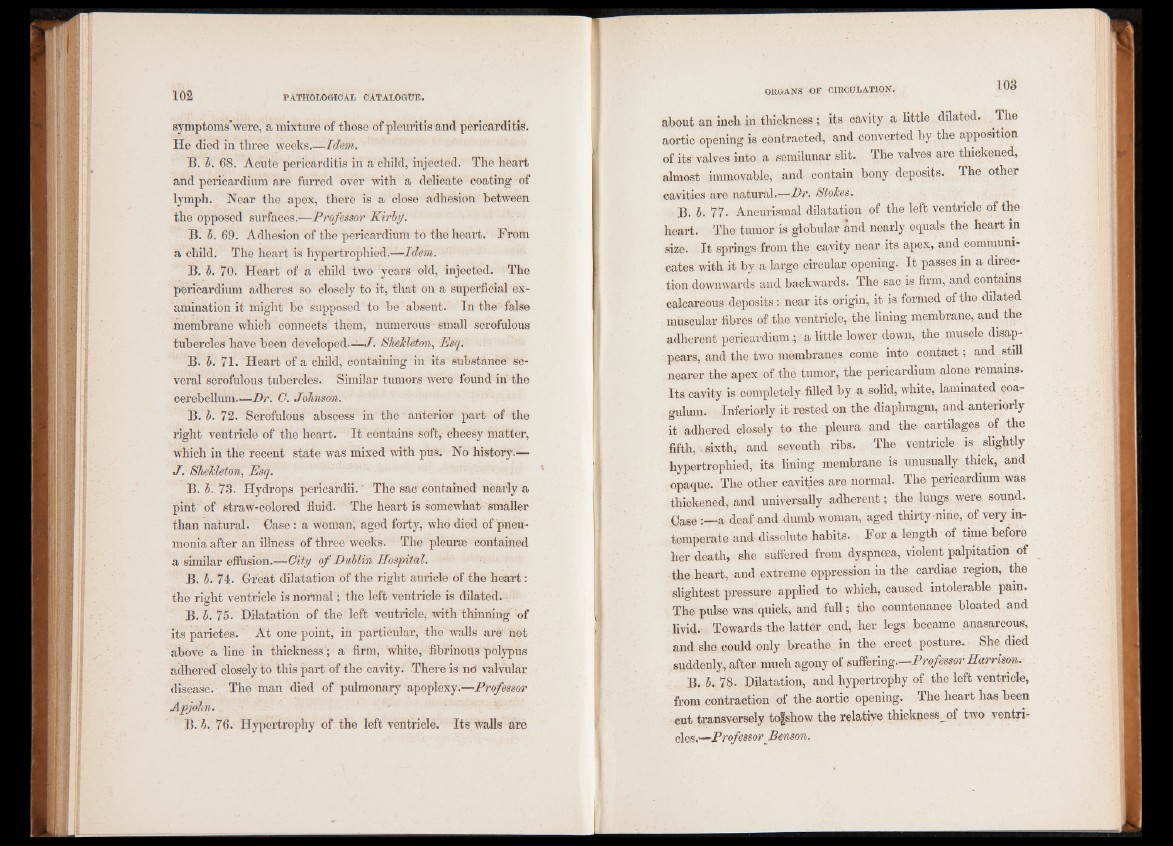
symptoms'were, a mixture of those of pleuritis and pericarditis.
He died in three weeks.—Idem.
B. b. 68. Acute pericarditis in a child, injected. The heart
and pericardium are furred over with a delicate coating of
lymph. Near the apex, there is a close adhesion between
the opposed surfaces.—Professor Kirby.
B. b. 69. Adhesion of the pericardium to the heart. From
a child. The heart is hypertrophied.—Idem.
B. b. 70. Heart of a child two years old, injected. The
pericardium adheres so closely to it, that on a superficial examination
it might be supposed to be absent. In the'false
membrane which connects them, numerous - small scrofulous
tubercles have been developed.—/. Shekleton, Esq.
B. b. 71. Heart of a child, containing in its substance several
scrofulous tubercles. Similar tumors were found in the
cerebellum—Dr. G. Johnson.
B. b. 72. Scrofulous abscess in the anterior part of the
right ventricle of the heart. It contains soft, cheesy matter,
which in the recent state was mixed with pus. No history.—
J. Shekleton, Esq.
B. b. 73. Hydrops pericardii. ‘ The sac contained nearly a
pint of straw-colored fluid. The heart is somewhat1 smaller
than natural. Case : a woman, aged forty, who died of pneumonia
after an illness of three weeks. The pleurae contained
a similar effusion.—City of Dublin Hospital.
B. b. 74. Great dilatation of the right auricle of the heart:
the right ventricle is normal ; the left ventricle is dilated.
B. b. 75. Dilatation of the left veutricle, with thinning of
its parietes. At one point, in particular, the walls are' not
above a line in thickness ; a firm, white, fibrinous polypus
adhered closely tó this part of the cavity* There is nd valvular
disease. The man died of pulmonary apoplexy.—Professor
ApjJhn. .
B. b. 76. Hypertrophy of the left ventricle. Its walls are
about an inch in thickness ; its cavity a little dilated. The
aortic opening is contracted, and converted by the apposition
of its valves into a semilunar slit. The valves are thickened,
almost immovable, and contain bony deposits. The other
eavities are natural.—Dr. Stokes.
B. b. 77. Aneurismal dilatation of the left ventricle of the
heart. The tumor is globular and nearly equals the heart in
size. It springs from the cavity near its apex, and communicates,
with it by a large circular opening. It passes in a direction
downwards and backwards. The sac is firm, and contains
calcareous deposits: near its origin, it is formed of the dilated
muscular fibres of the ventricle, the lining membrane, and the
adherent pericardium.; a little lower down, the muscle disappears,
and the two membranes come into contact; and still
nearer the apex of the tumor, the pericardium alone remains.
Its cavity is completely filled by a solid, white, laminated coa-
gulum. Inferiorly it rested on the diaphragm, and anteriorly
it adhered closely to the pleura and the cartilages of the
fifth, , sixth, and seventh ribs. The ventricle is slightly
hypertrophied, its lining membrane is unusually thick, and
opaque. The other cavities are normal. The pericardium, was
thickened, and universally adherent; the lungs were sound.
Case :—a deaf and dumb woman, aged thirty-nine, of very intemperate
and dissolute habits. For a length of time before
her death, she suffered from dyspnoea, violent palpitation of
the heart, and extreme oppression in the cardiac region, the
slightest pressure applied to which, caused intolerable pain.
The pulse was quick, and full; the countenance bloated and
livid. Towards the latter end, her legs became anasarcous,
and she could only breathe in the erect posture* She died
suddenly, after much agony of suffering— Professor Harrison.
B. b. 78. Dilatation, and hypertrophy of the left ventricle,
from contraction of the aortic opening. The. heart has been
cut transversely tofshow the relative thicknessmf two ventricles.—
Professor Benson.